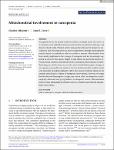Mitochondrial involvement in sarcopenia
| dc.contributor.author | Affourtit, C | |
| dc.contributor.author | Carré, JE | |
| dc.date.accessioned | 2024-02-05T11:32:27Z | |
| dc.date.available | 2024-02-05T11:32:27Z | |
| dc.date.issued | 2024-02-02 | |
| dc.identifier.issn | 1748-1708 | |
| dc.identifier.issn | 1748-1716 | |
| dc.identifier.uri | https://pearl.plymouth.ac.uk/handle/10026.1/22018 | |
| dc.description.abstract |
Sarcopenia lowers the quality‐of‐life for millions of people across the world, as accelerated loss of skeletal muscle mass and function contributes to both age‐ and disease‐related frailty. Physical activity remains the only proven therapy for sarcopenia to date, but alternatives are much sought after to manage this progressive muscle disorder in individuals who are unable to exercise. Mitochondria have been widely implicated in the etiology of sarcopenia and are increasingly suggested as attractive therapeutic targets to help restore the perturbed balance between protein synthesis and breakdown that underpins skeletal muscle atrophy. Reviewing current literature, we note that mitochondrial bioenergetic changes in sarcopenia are generally interpreted as intrinsic dysfunction that renders muscle cells incapable of making sufficient ATP to fuel protein synthesis. Based on the reported mitochondrial effects of therapeutic interventions, however, we argue that the observed bioenergetic changes may instead reflect an adaptation to pathologically decreased energy expenditure in sarcopenic muscle. Discrimination between these mechanistic possibilities will be crucial for improving the management of sarcopenia. | |
| dc.format.extent | e14107- | |
| dc.format.medium | Print-Electronic | |
| dc.language | en | |
| dc.publisher | Wiley | |
| dc.subject | cellular bioenergetics | |
| dc.subject | sarcopenia | |
| dc.subject | skeletal muscle mitochondria | |
| dc.title | Mitochondrial involvement in sarcopenia | |
| dc.type | journal-article | |
| dc.type | Review | |
| dc.type | Early Access | |
| plymouth.author-url | https://www.ncbi.nlm.nih.gov/pubmed/38304924 | |
| plymouth.issue | 3 | |
| plymouth.volume | 240 | |
| plymouth.publication-status | Published online | |
| plymouth.journal | Acta Physiologica | |
| dc.identifier.doi | 10.1111/apha.14107 | |
| plymouth.organisational-group | |Plymouth | |
| plymouth.organisational-group | |Plymouth|Research Groups | |
| plymouth.organisational-group | |Plymouth|Faculty of Health | |
| plymouth.organisational-group | |Plymouth|Research Groups|Institute of Translational and Stratified Medicine (ITSMED) | |
| plymouth.organisational-group | |Plymouth|Research Groups|Institute of Translational and Stratified Medicine (ITSMED)|CBR | |
| plymouth.organisational-group | |Plymouth|REF 2021 Researchers by UoA | |
| plymouth.organisational-group | |Plymouth|Users by role | |
| plymouth.organisational-group | |Plymouth|Users by role|Academics | |
| plymouth.organisational-group | |Plymouth|REF 2021 Researchers by UoA|UoA03 Allied Health Professions, Dentistry, Nursing and Pharmacy | |
| plymouth.organisational-group | |Plymouth|Faculty of Health|School of Biomedical Sciences | |
| plymouth.organisational-group | |Plymouth|REF 2028 Researchers by UoA | |
| plymouth.organisational-group | |Plymouth|REF 2028 Researchers by UoA|UoA03 Allied Health Professions, Dentistry, Nursing and Pharmacy | |
| dc.publisher.place | England | |
| dcterms.dateAccepted | 2024-01-22 | |
| dc.date.updated | 2024-02-05T11:32:27Z | |
| dc.rights.embargodate | 2024-2-6 | |
| dc.identifier.eissn | 1748-1716 | |
| rioxxterms.versionofrecord | 10.1111/apha.14107 |


